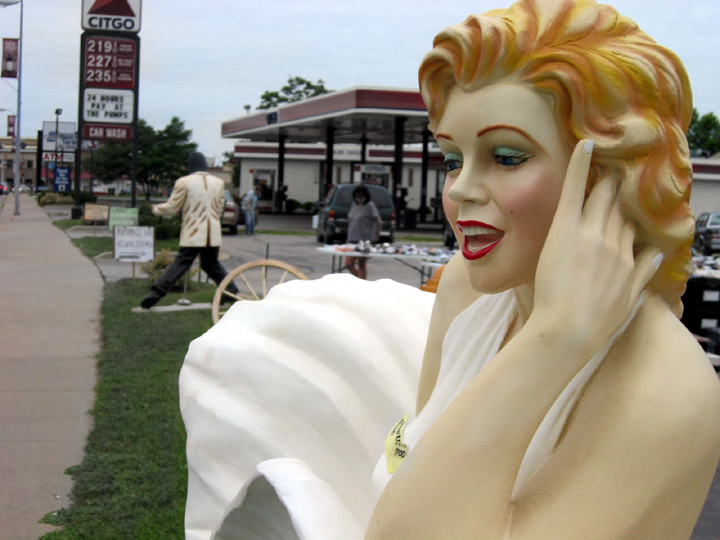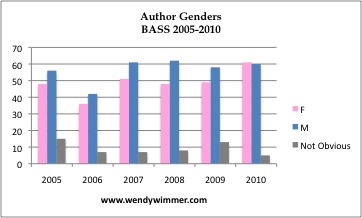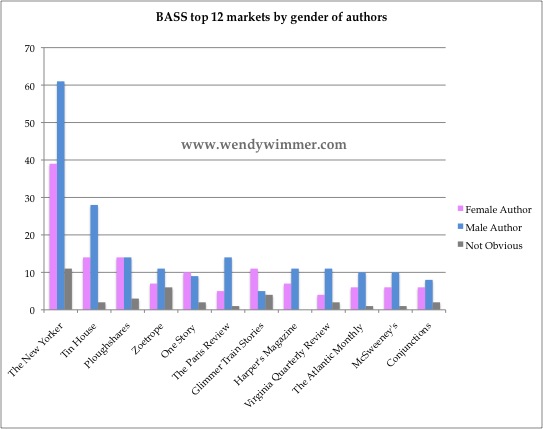
This one’s for the ladies!
We’ve already covered how over half of all BASS stories came from the same 12 sources from 2005 through 2010, so let’s move to my pet peeve about the literary community: the potential for bias against writers who are women. I posted this graph in a previous entry, but since it’s handy, let’s take a look at it again.

One could interpret these results one of two ways–Either females aren’t getting chosen for the BASS (with the exception of 2010, when even with the margin of error in the Not Obvious column, there’s no clear bias for either gender) or the stories that are published or mentioned in the BASS are a cross-section of what’s out there and women authors are not getting published as often as men in the journals that the BASS is using to collect its fiction. You decide what’s going on here.
The five most female-friendly BASS sources (and the bottom five too)
I took at look at that top 42 BASS markets (ie. where 80% of the BASS stories are originating) and stacked them based on percentage of female authors versus everyone else (Male author names as well as Not Obvious names). The five publications with the lowest ratio of female authors listed in the BASS (We’ll call them The Boys and Girls Club):
- Virginia Quarterly Review (23.5% female)
- Granta (25% female)
- The Paris Review (25% female)
- The Southern Review (26.7% female)
- Zoetrope (29.2% female)
It is my responsibility to defend some of these publications as potential victims of the data gathering process, as all of these publications have authors who had names which were Not Obvious male or female names (see table after the jump), and Granta and Zoetrope especially could have much higher female ratios within that margin of error. I hesitate even to include Granta in this list at all, because with only two female names and two Not Obvious against four male authors, it might even be a perfect split and then it’s super unfair to list them here. So please remember, this is not an indictment of these publications, just a measurement of my perception of their entries in the BASS.
Conversely, these five publications have the highest percentage of female authors in the BASS (let’s call them the The Girl Scouts)
- New England Review (84.6% female)
- Alaska Quarterly Review (75% female)
- The Sun (71.4% female)
- Ninth Letter (71.4% female)
- Missouri Review (71.4% female)
The delightful spouse has actually suggested that I go one step further and buy a year’s backlog of a few of the BASS top 12 and compile a census to compare ratio of gender published to gender selected so that one COULD validate the hypothesis that the BASS selection was a statistically random sampling of the stories selected for publication of those markets. But I’m not sure that I’m that crazy yet, as I do actually have to work for a living to keep the lights turned on.
I should also point out that it’s entirely unreliable to assume that because New England Review has such a high percentage of female authors in the BASS that they must be publishing more female authors in general. Not true. It’s also possible that they (or any other of the journals listed in either The Girl Scouts or The Boys Club) have the opposite bias in their overall publishing schema but the females (or males) they do pick are so exceptional that they defeat the journals own bias as well as get noticed by the BASS editors. We just won’t know unless we actually did a standard deviation calculation and some predictive calculations (did I mention that I have a Six Sigma certification? It’s true. And yes, that makes me a little weird.)
The Top 12 BASS Markets by Gender
Want to see how the Dirty Dozen play out in the war of the sexes? I thought you’d never ask.

While The New Yorker does not have an impressive female-to-male ratio of authors in the BASS, they have had more female authors listed/published in the BASS than any other publication. Woo girl power!? Of course, of The New Yorker‘s 39 females, Annie Proulx and Alice Munro make up 30% of that figure with 12 stories between the two of them.
In fact, many of the women authors are consistent players. Matt Bell dropped a hint that he’d be interested in seeing who the teacher’s pets (that’s my term, not Matt’s) of BASS were, so I will compile that data for a future post, including what the numbers look like when you take out the more famous writers and see who is left.
Before the ladies in the room start drafting up submissions to Glimmer Train and Ploughshares, please remember: this is not indicating that these publications are skewed or biased toward female authors anymore than it indicates that Tin House or Zoetrope are biased toward male authors. It’s simply a study of how those hungry BASS editors are nibbling from each market.
Speaking of how the editors are picking stories, I think I have a kindred spirit in Susan Gibb, who caught onto something hinky in the Michael Chabon-edited Best American Short Stories ’05.
As I mentioned, in February I read the 2005 Best American Short Stories and did brief reviews on the twenty selected stories here on Spinning. Last week I decided to read through the 2005 Best American Mystery Stories, something I was looking forward to since my roots are in the genre and I hadn’t read or written mystery in quite a while. Kind of strange, but I realized that the fifth story in BAMS, Old Boys, Old Girls by Edward P. Jones, was one I had just read in BASS. When I checked the index, I found Dennis Lehane’s Until Gwen. This story was also in the BASS collection.
It seems to me that there are so many stories published that it struck me as kind of a really, really amazing coincidence that two different guest editors (BASS, Michael Chabon; BAMS, Joyce Carol Oates) would, out of all those stories, select the same two to include in their separate collections (both are published as part of a Houghton Mifflin series). When I remembered that Joyce Carol Oates was one of Michael Chabon’s selections in BASS, I checked the BAMS for Chabon and confirmed he was not included.
Susan Gibb also warned me that I’m probably never going to get a story in the BASS after this. Yeah, this is a serious risk that I’m taking, but I want to believe that the BASS editors are can withstand a little inspection without taking it personally. And since it IS my goal to have a short story in the BASS, I’m simply taking a page from Sun Tzu and trying to get a better understanding of the playing field.
As always, for my two data-hungry readers, there are tables at the bottom of this post just waiting for you to love them after the break!
White Lies and Statistics
This is the overall breakout of published and notable stories, broken down by gender, which is the data used for the first chart above.
| Gender of Author | 2005 | 2006 | 2007 | 2008 | 2009 | 2010 | Total |
| Female Author | 48 | 36 | 51 | 48 | 49 | 61 | 293 |
| Male Author | 56 | 42 | 61 | 62 | 58 | 60 | 339 |
| Not Obvious | 15 | 7 | 7 | 8 | 13 | 5 | 55 |
Below is an extended detail of the subset used for the “BASS Top 12 markets by gender of author” chart. Obviously, there are more than 12 markets listed here, because I wanted to show you something interesting by highlighting what I considered to be bias against feminine author names (30% or less female names) versus bias against masculine author names (70% or higher female names).
It’s interesting that the publications with higher percentages of male authors are skewing to be larger contributors to the BASS while publications with higher percentages of female authors are skewing to be lesser contributors to the BASS.
Methodology of Determining Gender
Now, clearly the “Not Obvious” authors actually have a gender and that gender is likely known to the editors of the BASS, either by reading the author bios within the lit journals (and of course many of them come with photographs) or through simple research, but I’m working with the assumption that if I didn’t automatically know the author was male or female, then the editor probably didn’t either. This is probably a faulty assumption. Technically, TC Boyle would have a Not Obvious name if he weren’t so damned famous that everyone knows he’s a he. Regardless, the Not Obvious column should be treated as a margin of error on the % Female total. I think I just lost every English major in the crowd so if you’re still reading this, bravo! You deserve a gold star for today!
Indicates prevalence of female author names selected by BASS (Over 70% female)
Indicates prevalence of male author names selected by BASS (Under 30% female)
| Female Author | Male Author | Not Obvious | Grand Total | % Female | |
| The New Yorker | 39 | 61 | 11 | 111 | 35.1% |
| Tin House | 14 | 28 | 2 | 44 | 31.8% |
| Ploughshares | 14 | 14 | 3 | 31 | 45.2% |
| Zoetrope | 7 | 11 | 6 | 24 | 29.2% |
| One Story | 10 | 9 | 2 | 21 | 47.6% |
| The Paris Review | 5 | 14 | 1 | 20 | 25.0% |
| Glimmer Train Stories | 11 | 5 | 4 | 20 | 55.0% |
| Harper’s Magazine | 7 | 11 | 18 | 38.9% | |
| Virginia Quarterly Review | 4 | 11 | 2 | 17 | 23.5% |
| The Atlantic Monthly | 6 | 10 | 1 | 17 | 35.3% |
| McSweeney’s | 6 | 10 | 1 | 17 | 35.3% |
| Conjunctions | 6 | 8 | 2 | 16 | 37.5% |
| The Southern Review | 4 | 10 | 1 | 15 | 26.7% |
| Antioch Review | 6 | 6 | 1 | 13 | 46.2% |
| New England Review | 11 | 2 | 13 | 84.6% | |
| American Short Fiction | 3 | 6 | 9 | 33.3% | |
| The Iowa Review | 3 | 4 | 1 | 8 | 37.5% |
| Alaska Quarterly Review | 6 | 2 | 8 | 75.0% | |
| Narrative Magazine | 3 | 5 | 8 | 37.5% | |
| Granta | 2 | 4 | 2 | 8 | 25.0% |
| Five Points | 3 | 4 | 1 | 8 | 37.5% |
| The Sun | 5 | 2 | 7 | 71.4% | |
| A Public Space | 3 | 3 | 1 | 7 | 42.9% |
| The Kenyon Review | 2 | 4 | 1 | 7 | 28.6% |
| Prairie Schooner | 4 | 3 | 7 | 57.1% | |
| Epoch | 4 | 2 | 1 | 7 | 57.1% |
| Oxford American | 3 | 4 | 7 | 42.9% | |
| Ninth Letter | 5 | 2 | 7 | 71.4% | |
| Missouri Review | 5 | 2 | 7 | 71.4% |
One Comment
Wendy, just to clarify my inclusion here: I think your characterization of my wanting to know who’s been in BASS the most as who the “teacher’s pets” are (your phrase, not mine) makes it sound like my query was negative, which wasn’t how I meant it– I wasn’t complaining, just curious. Obviously, some people really do write great stories more than others, and deserve to be recognized as often as that’s the case. I personally don’t have any complaints with the series editors of BASS and BAMS (full disclosure, although you may already know this from your analysis, both of these anthologies have recognized my work) Even if I did, as an editor myself I’d absolutely defend their right to choose the works by whatever methods they wish–That’s what being an editor is.
Of course, whatever they pick is going to be criticized by someone, but I think trying to find “fairness” in the numerical way you’re searching for can be a bit misguided, because some writers truly are dramatically better than others, and some magazines really do publish a disproportionate amount of the best work, and that deserves to be recognized.
Editing an anthology of this scope and scale isn’t necessary going to ever produce results that are “fair” in the way your graphs seem to suggest you’d prefer, especially not if the editors are also trying to pick what’s “best.” It’s a subjective process, obviously, but again: this is what being an editor is. It’s not about pleasing everyone, or being “fair.” It’s about making the best publication you can, according to your own tastes, aesthetics, and motivations. As long as these editors honestly feel they’ve done that, then to me they’ve done their job.
2 Trackbacks/Pingbacks
[…] This is Part One of a series analyzing the Best American Short Stories anthologies from 2005-2010. For part two, read “The top five best BASS markets for women writers (and five not-so-great)” […]
Great Short Works…
[…] or my two data-hungry readers, there are tables at the bottom of this post just […]…